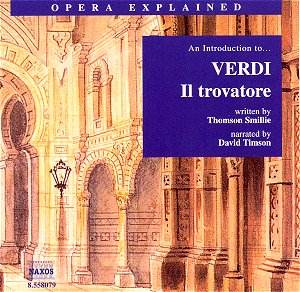As my reviews of ĎLíelisir
díamoreí and ĎThe
Marriage of Figaroí in this series
indicate, I am quite an enthusiast of
this format. A nice balance of clarity
and erudition is struck in the introduction
to each opera and also in the explanatory
narrative supporting the musical extracts.
It was therefore with some disappointment
that I found the background introduction
to this Trovatore (trs. 1-5), the second
of Verdiís great middle period trio,
so brief - a mere 18 minutes. It may
be that this is because there have already
been CDs devoted to the other two of
that trio, Rigoletto and Traviata. These
operas are also dealt with here (trs.
4 and 5). Musical excerpts also juxtaposed
with references to Verdiís troubles
with the censor. This issue of censorship
is introduced (tr. 3) as the author
extends consideration of Verdiís middle
period to Aida and Don Carlos. Smillie
attributes Papal influence to the censorís
decisions and makes the case for the
composerís atheist view of Catholicism
influencing his attitude. Tracks 1 and
2 briefly relate Verdiís place in the
political history of Italy (tr. 1),
and notes how the music became identified
with the struggle for the unification
and liberation from foreign occupation
issues that reached a peak during this
period. Audiences had already identified
their situation of oppression with many
choruses from earlier Verdi operas to
the extent of civil disorder during
and after performances. These included
cries of the acrostic ĎViva Verdií.
More could have been made (tr. 2) of
the composerís responses to the various
developments in the fight for unification
including his financial support for
Garibaldiís wounded soldiery. This would
have left him very exposed if the Austrians
had taken Piedmont. Verdi was very much
at the centre of developments, at crisis
points in this turbulent period of Italyís
gestation.
Track 6 about the genesis
of Il Trovatore makes some very worthwhile
points on the relationship of Verdi,
and of other operatic composers, to
how we remember certain authors and
their works. It also gives a realistic
assessment of the so called absurdity
of the plot. Track 7 gives a very clear
analysis of the characters in the opera
and what had gone on before the curtain
fell. This is very important if the
absurdity argument is to be refuted
and the actual cohesive nature of the
plot fully comprehended. The remaining
tracks take the listener through the
opera. The narrative is nicely balanced
by musical illustration derived from
the complete Naxos recording which is
by the way vibrant. And all this despite
lacking the worldís greatest singers
- a prerequisite according to Caruso
for successful performances of Il Trovatore.
If my previous reviews
have converted the reader to this series,
do not let my minor criticisms deter
from the purchase of this issue. This
disc will greatly help anybody new to
the work. It is one of Verdiís most
tuneful operas from that glorious middle
period.
Robert J Farr
